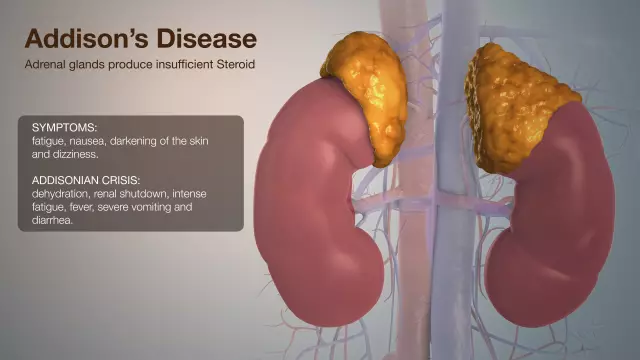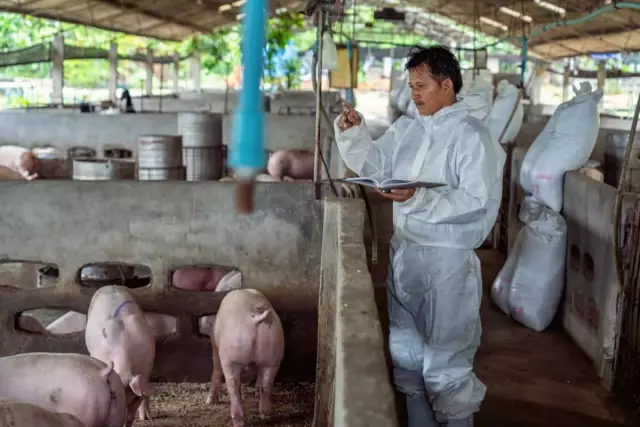- Author Rachel Wainwright [email protected].
- Public 2023-12-15 07:39.
- Last modified 2025-11-02 20:14.
Bowen's disease
The content of the article:
- Causes and risk factors
- Forms of the disease
- Symptoms
- Diagnostics
- Treatment
- Possible complications and consequences
- Forecast
- Prevention
Bowen's disease is a rare skin disease that is initially in situ cancer (stage 0 intraepithelial cancer, which is a collection of altered cells that do not invade surrounding tissues).
Pathology was first described by J. T. Bowen in 1912, after whom it was named in 1914.
Diseases are more likely to affect older people, men and women equally. The lesions are usually single, less often they can be located in groups, most often localized in the epidermis of the head (46%), palms (14%), genitals (10%). Mucous and semi-mucous membranes are affected in about 10% of cases. The genitals are involved in the pathological process mainly in elderly men; in women, such an arrangement of foci is extremely rare.

Bowen disease cutaneous manifestations
Causes and risk factors
Bowen's disease can be caused by various reasons:
- chronic intoxications (resins, hydrocarbon compounds, arsenic, etc.);
- excessive sun exposure;
- age-related degenerative skin changes;
- previous traumatization of the skin;
- human papillomavirus (HPV) infection;
- exposure to ionizing radiation.
The role of viral agents in the development of the disease has not yet been reliably confirmed.

Human papillomavirus infection is a predisposing factor for the development of Bowen's disease
Some authors described the development of Bowen's disease against the background of previous dermatoses and various skin changes: Mibelli porokeratosis, keratinizing cyst, Lewandowski-Lutz epidermodysplasia, Kaposi's angioreticulosis, actinic keratosis, lichen planus, discoid lupus erythematosus, etc.
Forms of the disease
Depending on the external manifestations, several forms of the disease are distinguished:
- annular (annular);
- verrucous (warty);
- pigmented;
- damage to the nail bed, characterized by discoloration of the nail plate, peeling it from the underlying soft tissues or erosion with crusts and peeling around the nail.
By localization of the pathological process:
- arising in places exposed to direct sunlight (open parts of the body);
- on closed areas of the skin.
Symptoms
The disease is manifested by the appearance of single (in some cases - multiple) lesions of pink-red or red-brown color with an indistinct border, which are gradually transformed into plaques that slightly rise above the level of unchanged skin.
The plaques are characterized by slow peripheral growth, round or oval shape; less often, skin defects have polymorphic outlines. The surface of the inflammatory focus is uneven, granular, covered with yellowish crusts and scales, when removed, a moist, shiny bloodless wound is exposed.
Visually, inflammatory foci are distinguished by variegation: zones of hyperpigmentation are adjacent to areas of clinically unchanged skin.

External manifestations of Bowen's disease
As the progression progresses (with the long-term existence of the pathology), superficial ulceration is noted with the formation of partially scarring erosions, an increase in the area of the lesion, or the merging of several foci into one extensive lesion.
On the oral mucosa, Bowen's disease usually manifests itself in the form of single, flat, slightly sunken, sometimes with zones of increased keratinization (but more often papillomatous) lesions. Predominantly papillomatous in nature are also lesions in the eyelids, more often the upper eyelid. The disease, localized on the mucous membranes, proceeds much more intensively, with early malignancy.
As a rule, the disease is not accompanied by subjective disorders, occasionally patients complain of itching or burning.
Usually, in the absence of appropriate treatment, the disease progresses steadily, although cases of a lifelong course without progression have been described.
Diagnostics
The diagnosis is formed on the basis of the clinical picture and the results of a histological examination of a biopsy of the affected skin area.
For a correct diagnosis, it is necessary to differentiate Bowen's disease with a number of pathologies with similar manifestations: eczema, psoriasis, solar and seborrheic keratosis, warty tuberculosis of the skin, senile keratoma, vulgar wart, basalioma, bowenoid papulosis, melanoma or in situ peghetoma disease.

Biopsy helps differentiate Bowen's disease from other skin pathologies
The pathomorphology of a biopsy specimen in Bowen's disease has specific characteristics: an increase in the number of spiny cells of the epidermis in its germ layer with elongated epithelial cords penetrating into the dermis, proliferation and vacuolization of atypical styloid cells, especially in the upper layers, the presence of large round cells with eosinophilic protoplasm or large oval nucleus (Bowen cells), frequently occurring figures of mitosis, lump formation of nuclei inside multinucleated epidermal giant cells, dyskeratosis, formation of true "horn pearls". The basal layer is preserved. When it is violated, a picture of a typical spinocellular carcinoma develops. In the dermis, there is a chronic inflammatory reaction from lymphocytes, histiocytes, and plasma cells.
Treatment
Treatment of the disease depends on the area and severity of inflammatory changes.
With a small size of the skin defect (up to 2 cm), ointments and applications with cytostatics, the use of dermatotropic antipsoriatic agents are shown.
If the size of the focus of inflammation is more than 2 cm, it is recommended to remove it with the help of surgery, electrocoagulation, cryodestruction, close-focus X-ray therapy, laser therapy.
Possible complications and consequences
The main threatening consequence of Bowen's disease is progressive malignancy into squamous cell carcinoma with invasion of the surrounding soft tissues and metastasis.

Bowen's disease can develop into squamous cell skin cancer
In addition, the following complications are possible:
- infection of the inflammatory focus;
- ulceration of plaques;
- sepsis.
The data from studies of the frequency of association of Bowen's disease with malignant neoplasms of internal organs are ambiguous: the authors, indicating the connection, found cancer of the internal organs in 57% of deaths from Bowen's disease. Nevertheless, in additional studies, a significant increase in the incidence of cancer of internal organs was observed only in patients with lesions in closed skin areas (33%), while in Bowen's disease in open skin areas, the frequency of visceral cancer was only 5%.
Forecast
The prognosis depends on the timeliness and volume of medical care: the probability of Bowen's disease degenerating into squamous cell carcinoma varies from 11 to 80%, depending on the length of the disease.
Prevention
Adherence to the following preventive measures reduces the likelihood of developing Bowen's disease:
- protection of the skin from excessive sun exposure, exposure to harsh chemicals;
- timely seeking medical help when a characteristic skin defect appears;
- refusal of self-medication in case of confirmation of the diagnosis.

Olesya Smolnyakova Therapy, clinical pharmacology and pharmacotherapy About the author
Education: higher, 2004 (GOU VPO "Kursk State Medical University"), specialty "General Medicine", qualification "Doctor". 2008-2012 - Postgraduate student of the Department of Clinical Pharmacology, KSMU, Candidate of Medical Sciences (2013, specialty "Pharmacology, Clinical Pharmacology"). 2014-2015 - professional retraining, specialty "Management in education", FSBEI HPE "KSU".
The information is generalized and provided for informational purposes only. At the first sign of illness, see your doctor. Self-medication is hazardous to health!






